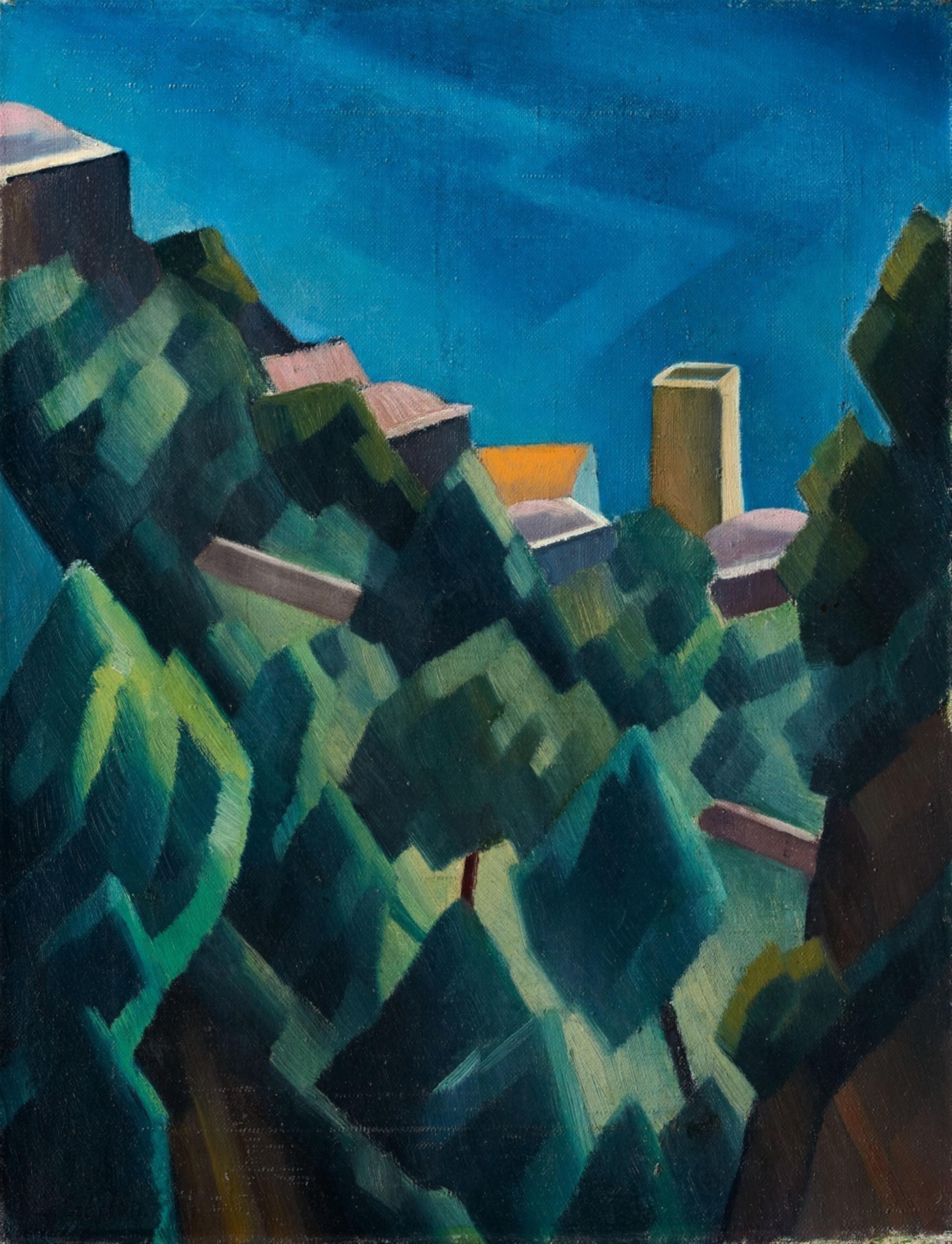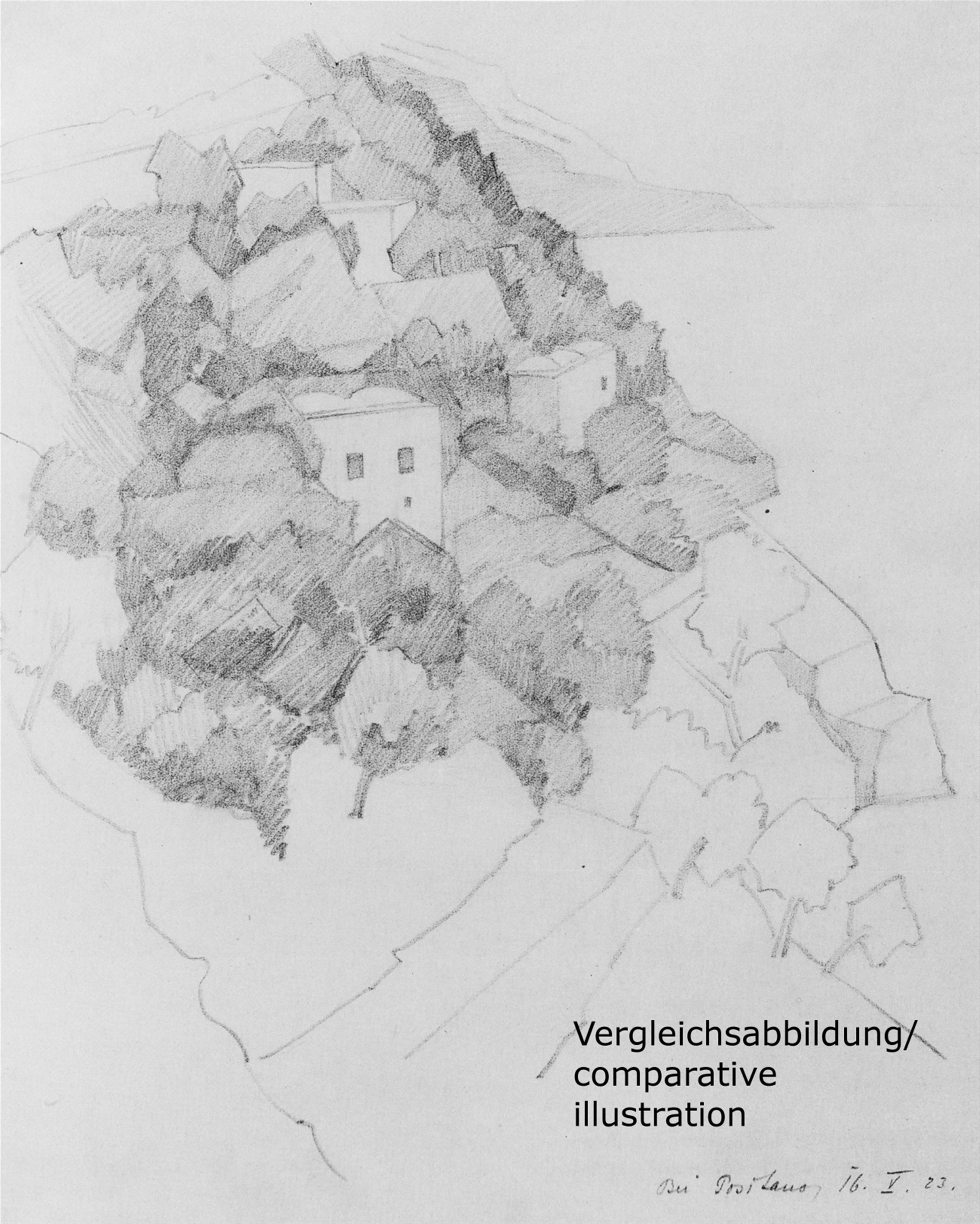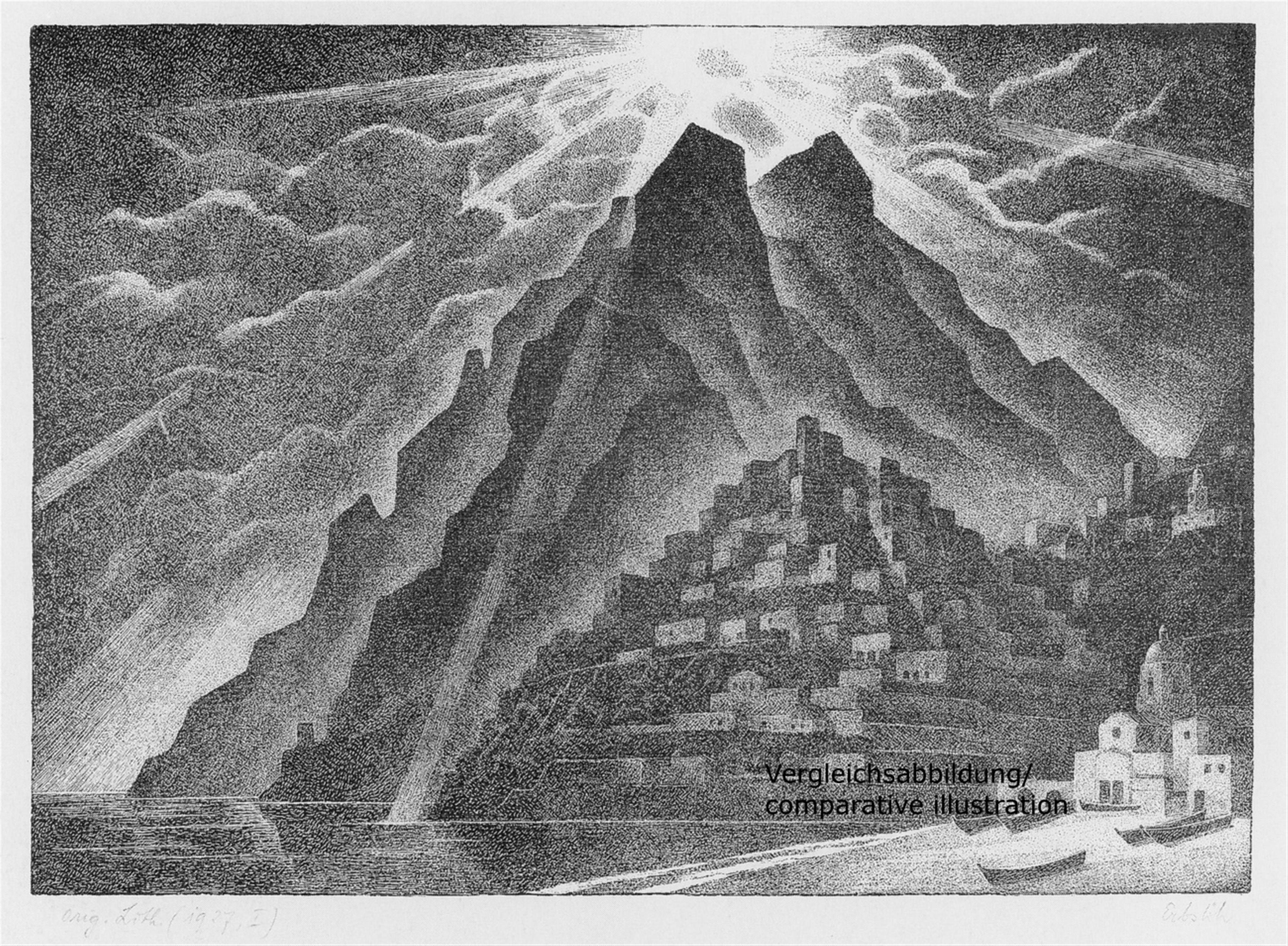Adolf Erbslöh
Am Meer bei Positano ("Marine in Positano", "Aus Positano")
1923
Oil on canvas 48.2 x 37.2 cm Framed. Signed 'A. Erbslöh.' (indistinctly) in dark blue lower left. - With label of "MODERNE GALERIE THANNHAUSER” to the upper left on the reverse of the stretcher, therein hand-written no. “7387” in red ink; on the right side a machine-typed exhibition label by the Kunstverein Barmen from 1931. - Upper left corner with minor rubbing.
Adolf Erbslöh set out for Italy in 1923, visiting Olevano, Positano and Civitella as well as Capri. To date it has been assumed that Alexander Kanoldt, Erbslöh's early friend and fellow student, accompanied him. The journey would lastingly shape Erbslöh's painting and composition through his experience of new landscape motifs - the steep Mediterranean coasts with the characteristic, piled-up architecture of their villages and towns. It brought about an artistic peak and an almost imperceptible stylistic break, which led him away from the aesthetic means of Expressionism, in its widest sense, and towards what would soon thereafter be referred to as the “New Objectivity”. However, it remains a characteristic feature of his work that it cannot be grasped directly by way of this stylistic terminology: he maintained his distance artistically, and he amalgamated in his own way what he saw and felt as well as formally explored, oscillating between the perception of nature and abstraction. By his own account Cézanne and Jawlensky provided the major models for his pictorial architecture.
Hans Wille has already referred to the discovered motif of Positano “as the most important formal experience of his stay in Italy.” (Hans Wille, Adolf Erbslöh, Zeichnungen, exhib. cat. Hamm/Kamen/Solingen/Soest, Hamm 1986, p. 63). All of Erbslöh's artistic idiosyncrasies positively crystallised around this motif, and its exceptional status would also find sustained expression in other media, such as the drawings created there and lithography.
Previously documented only in a black-and-white photograph by the artist, the present painting comes from the collection of Richart Reiche, who became head of the Barmen Kunstverein in 1907. From the very beginning he supported exhibitions with works from the Neue Künstlervereinigung München, Der Blaue Reiter, Die Brücke and others. Solo exhibitions of Erbslöh's works were shown in Barmen in 1909 and then later in 1922, 1925 and 1928. Finally in 1931, for the artist's 50th birthday, Reiche organised a retrospective at which “Am Meer bei Positano” could also be seen (cf. Hans Wille, Adolf Erbslöh, Recklinghausen 1982, pp. 37 f.). Prior to that the work had been exhibited at Munich's Galerie Thannhauser (probably at one of the solo exhibitions of 1923 or 1926).
In a compact composition, the painting depicts a steep stretch of coast seen as though from an elevated vantage point: a view on to the blue water which remains as a breathtaking experience in the memory of every visitor to the Mediterranean. The unmediated collision of the foreground and background, the rhythmically shifted elements of the architecture and the mountain formations and vegetation, which seem to merge into one another in a manner formally echoing Cubism, are combined to great effect with a nuanced palette of cool colours harmonised with one another. This perspective of a gaze downward from above stands in an inverted relationship to the breadth and distance otherwise favoured by Erbslöh in his views of mountains. Nonetheless, they are linked by an almost “magical” element in the trajectory and articulation of the light, suggested here by an unreal jagged movement on the blue surface. While it may seem to indicate the natural phenomenon of the play of shadows caused by the wind and current on the water, it is primarily a dynamic form that both cautiously and expressively extends the structural contrasts in the composition and in the motif as a whole downward from the top. The viewers' gaze glides down past and below them as though along sharply formulated serpentines; in spite of the resistance of the presented style of the painting's pronounced logic and solidity, their gaze is nevertheless held floating in space in a very subtle manner.
Catalogue Raisonné
Salmen/Billeter 1923/9 ("Whereabouts unknown"); not recorded by Wille
Listed in a later list of works by the artist under no. 234 ("Marine in Positano [...] Sommer 1923"); after a b/w photograph by Erbslöh documented as "Aus Positano 23".
Provenance
Formerly collection Dr. Richart Reiche, Barmen; Estate Dr. Ekkehart Reiche; Private possession since, Hesse
Literature
Brigitte Salmen/ Felix Billeter, Adolf Erbslöh 1881-1947, Werkverzeichnis der Gemälde, Munich 2016, cf. pp. 34 f.; p. 182, illus.; Sabine Fehlemann (ed.) and Antje Birthälmer, Adolf Erbslöh. Vom Expressionismus zum neuen Naturgefühl, Katalog des Von der Heydt-Museums Wuppertal, Wuppertal 2000, cf. pp. 11 f.
Exhibitions
Barmen May 1931 (Kunstverein in Barmen, Ruhmeshalle), Adolf Erbslöh 1881-1931, Ausstellung, cat. no. 62 ("Am Meer bei Positano")






